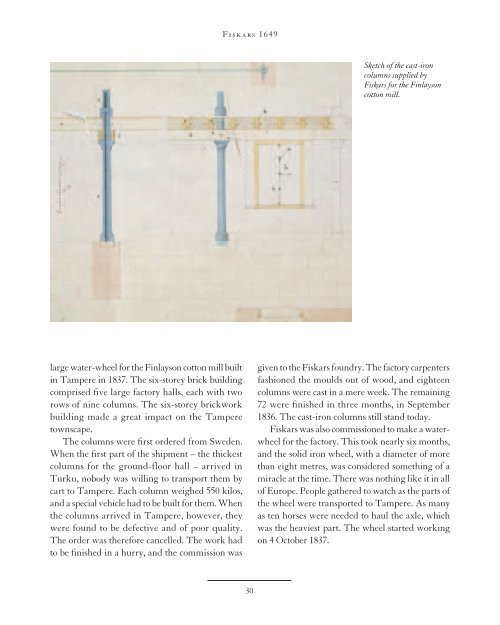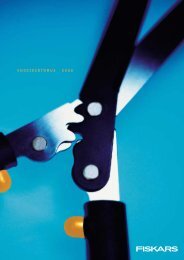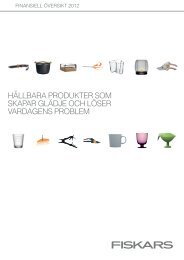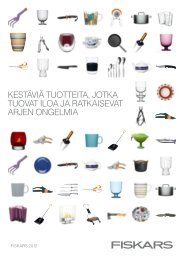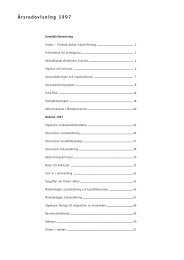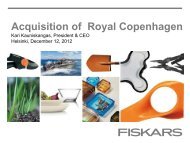FISKARS 1649 â 360 years of Finnish industrial history
FISKARS 1649 â 360 years of Finnish industrial history
FISKARS 1649 â 360 years of Finnish industrial history
You also want an ePaper? Increase the reach of your titles
YUMPU automatically turns print PDFs into web optimized ePapers that Google loves.
Fiskars <strong>1649</strong><br />
Fiskars <strong>1649</strong><br />
Sketch <strong>of</strong> the cast-iron<br />
columns supplied by<br />
Fiskars for the Finlayson<br />
cotton mill.<br />
large water-wheel for the Finlayson cotton mill built<br />
in Tampere in 1837. The six-storey brick building<br />
comprised five large factory halls, each with two<br />
rows <strong>of</strong> nine columns. The six-storey brickwork<br />
building made a great impact on the Tampere<br />
townscape.<br />
The columns were first ordered from Sweden.<br />
When the first part <strong>of</strong> the shipment – the thickest<br />
columns for the ground-floor hall – arrived in<br />
Turku, nobody was willing to transport them by<br />
cart to Tampere. Each column weighed 550 kilos,<br />
and a special vehicle had to be built for them. When<br />
the columns arrived in Tampere, however, they<br />
were found to be defective and <strong>of</strong> poor quality.<br />
The order was therefore cancelled. The work had<br />
to be finished in a hurry, and the commission was<br />
given to the Fiskars foundry. The factory carpenters<br />
fashioned the moulds out <strong>of</strong> wood, and eighteen<br />
columns were cast in a mere week. The remaining<br />
72 were finished in three months, in September<br />
1836. The cast-iron columns still stand today.<br />
Fiskars was also commissioned to make a waterwheel<br />
for the factory. This took nearly six months,<br />
and the solid iron wheel, with a diameter <strong>of</strong> more<br />
than eight metres, was considered something <strong>of</strong> a<br />
miracle at the time. There was nothing like it in all<br />
<strong>of</strong> Europe. People gathered to watch as the parts <strong>of</strong><br />
the wheel were transported to Tampere. As many<br />
as ten horses were needed to haul the axle, which<br />
was the heaviest part. The wheel started working<br />
on 4 October 1837.<br />
When it was completed in 1837, the Tampere<br />
cotton mill, with its six floors was the largest<br />
<strong>industrial</strong> facility in Finland and assumed a<br />
prominent position in the townscape.<br />
Diagram <strong>of</strong> the first Finlayson waterwheel.<br />
Next page: Fine forgers began their training<br />
at an early age. Interior at the Fiskars cutlery<br />
mill early 20th century.<br />
30<br />
31


